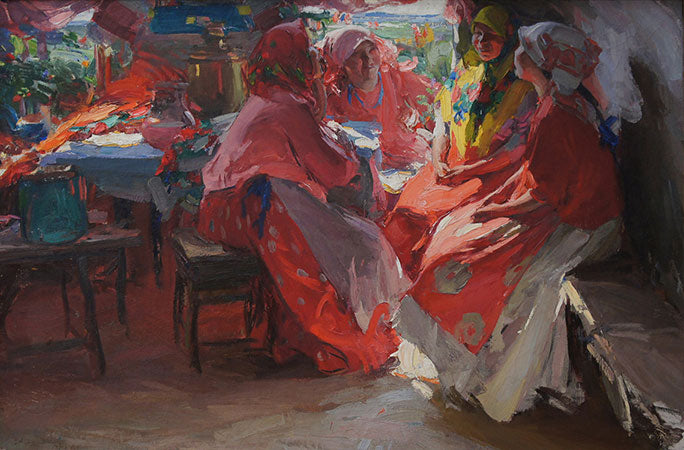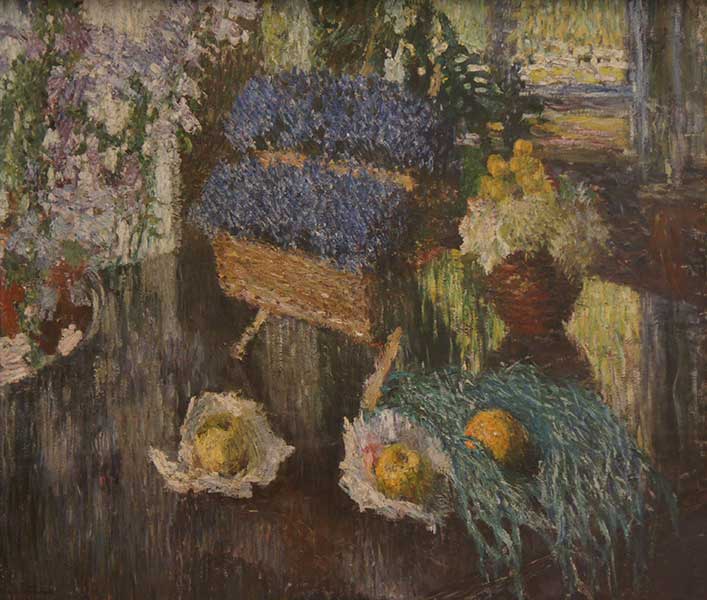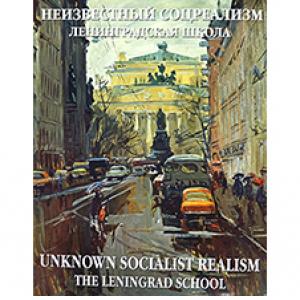Russian Impressionism
by Cathy Locke

Philippe Malyavin, “Whirlwind,” 1906, oil on canvas, Tretyakov Gallery
The 1905 Revolution and Bloody Sunday became the cornerstone upon which Russian artists developed their own unique style of post-impressionism. Just like Russian Impressionism, Russian Post-Impressionism did not mimic its European counterparts. Painters like Vincent Van Gogh and Paul Gauguin were creating work that was distinctively different from the European Impressionists and by 1910 Russian Impressionism were also undergoing a series of changes. Light, soft colors started to shift to richer reds and ochres. Brushstrokes became shorter and more directional with the use of flat-bristled brushes. Shadows became more active by using lighter and brighter shades of color. In addition, there were distinct differences between the artists from Moscow and those from St. Petersburg. The Russian artist, Igor Grabar, was influenced by French Impressionism worked in the style of divisionism starting in 1904, using pointillist-type brushstrokes of pure color. In 1907, the French Fauvists elected Grabar to become a member for life at their Salon d’Automne.

Igor Grabar, “Flowers and Fruits,” 1904, oil on canvas, Russian Museum

Igor Grabar,“Still Life,” 1907, oil on canvas, Tretyakov Gallery
The motif of social criticism started to return in the works of Russian Post-Impressionists. Valentin Serov, also considered one of the fathers of Russian Impressionism, fine-tuned the psychological portrait, which was a device handed down from his teacher, Ilya Repin. Abram Arkhipov’s work from 1915 to his death in 1930 seems to be a prelude to the propaganda of Soviet Realism. Stylistically, one cannot argue that the works by these Russian artists was not influenced by the loose brushwork of their European counterparts. However, the Russian works from 1900 to 1930 do not seem to have the same abandonment of a social statement or nationality as those of the Europeans.

Abram Arkhipov, “Being on a Visit,” 1915, oil on canvas, Russian Museum

Abram Arkhipov, “Girl,” 1920, oil on canvas, Russian Museum
Russian Impressionism continued to exist as a movement throughout the 1910s. Unfortunately, the public’s interest in Impressionism started to fade as the Russian Avant-Garde and neoclassicism started to emerge.Korovin’s lovely Portrait of Fyodor Chaliapin (1911) did not receive one kind word when it was exhibited. Gone were the pure appreciation of color and light, the nation had turned its attention to the revolution and the art that supported political change. After the 1917 Revolution many of the Russian Impressionists, including Korovin, Sergei Vinogradov and Malyavin, emigrated. Grabar, Arkhipov, Vasnetsov and Sergei Gerasimov remained in Russia and continued to work in Moscow, and their work became the classics of the new Soviet art. Russian Impressionism continued even through the Stalin era of Soviet Realism. Sergei Gerasimov, a student of Korovin, painted in an impressionistic style while working on Stalin-approved themes. By 1932, Stalin condemned impressionism as “decadent” art. The movement, based on harmonic union of the human with the surrounding environment, was in direct contradiction with the values set by Communist ideology. Stalin’s decree literally crippled the artistic fate of many Russian painters. After Stalin’s death in 1952, new works emerged, such as Alexei and Sergei Tkachev’s Children (1957-1960) and Arkady Plastov’s Midday (1961), that seemed to pick up the impressionist spirit from the past.

Alexei and Sergei Tkachev, “Children,” 1957-1960, oil on canvas
There are many gallery dealers around the world today who claim that Russian Impressionism and Post-Impressionism movements are still alive and well, spanning over 100 years. Personally, I question even using the term “Russian Post-Impressionism.” Rather, should it not be “Pronto Soviet Realism” or even “Revolutionary Impressionism?”

Philippe Malyavin, “Verka,” 1913, oil on canvas, Russian Museum

Philippe Malyavin, “A Girl,” 1903, oil on canvas, Russian Museum

Isaak Brodsky, “Portrait of the Artist’s Wife, Lubov Brodskaya, on the Terrace,” 1908, oil on canvas, Russian Museum

Igor Grabar,“Chrysanthemums,” 1905, oil on canvas, Tretyakov Gallery

Vyacheslav Zagonek, “Morning,” 1959-1960, oil on canvas, Russian Museum









